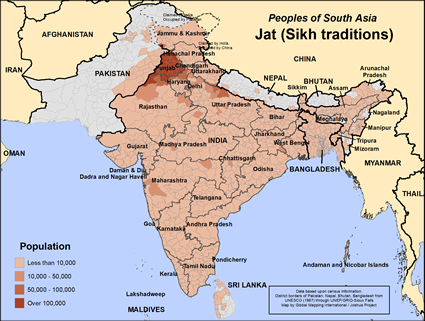The Jats are immersed in several ethnic groups who retain an identity often based on occupation and heritage. The word "Jat" is from the Arabic word "jatta" referring to the inhabitants of what is now much of Pakistan and Northwest India. They arrived in the sub-continent as invaders yet did not establish ruling dynasties. They were presumably Indo-Iranian who in the course of time they mixed with other invaders and older Indian inhabitants.
The greatest concentrations of Jats are found in states of Punjab and Haryana. They make up to one third of the population in Mirpur (Jammu and Kashmir), Gujranwala Multan, Muzaffargarh, Manipuri, Bahawalpur, Patkiala, Faridkot (Punjab) Rohtak and Mahendragarh (Haryana).
A popular occupation among Jats is farming. A small percentage are traders and laborers.
Jat Sikhs marry in front of Guru Granth Sahib like all other Sikhs. Some just sit and hear the sermons, while others go around the book four time (with rounds called laanvan).
Widow remarriage is allowed but she cannot marry her younger brother-in-law or near relatives of her deceased husband. The dead are cremated except children under seven who are buried.
They eat unleavened bread (roti) and curry, seasonal vegetables, ghee and milk. Girls are tattooed before marriage. Women are fond of jewelry and wear bangles made of ivory, lac (a resinous material) or clay but never glass.
When a man dies, his widow goes around his body seven times in the reverse direction of the one during marriage, indicating the undoing of marriage. She breaks a few of her bangles.
Sikhism originated from a 15th century teacher named Guru Nanak Dev as a reform movement. He rejected the Hindu caste system, taught that all people were equal and that all have equal access to God. The Sikh God is formless, without gender and is to be found in everyone. One gets closer to God by living a good life and by practicing charity. Like Hindus, Sikhs believe in reincarnation and the law of karma; you reap what you sow in your previous life. Like Muslims, the Sikhs worship only one God.
One may recognize a Sikh man by his distinctive turban. All the 10 great Sikh gurus wore turbans. Sikh teaching mandates that a person not cut his or her hair. They worship their holy book, the Granth Sahib, which is a collection of hymns.
There are roughly the same number of Sikhs as there are Jews in the world, but Sikhs are most concentrated in Punjab, their homeland. However, you will find smaller numbers of Sikhs all over the world. Many of the best Indian restaurants in the West are owned and operated by Sikhs.
Like all other peoples of the world, this people group needs the blessings and guidance that only Jesus Christ can offer.
Ask the Lord to call people who are willing to go to India and Nepal and share Christ with all Sikh Jat communities.
Pray that the Holy Spirit will soften their hearts towards Jesus to the point where they will give him their full devotion.
Ask God to call out prayer teams to break up the soil through worship and intercession.
Ask the Lord to raise up a triumphant church planting movement among Sikh Jats for the glory of His name.
Scripture Prayers for the Jat (Sikh traditions) in India.
| Profile Source: Joshua Project |












